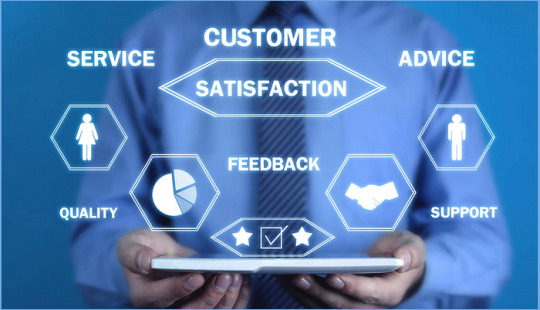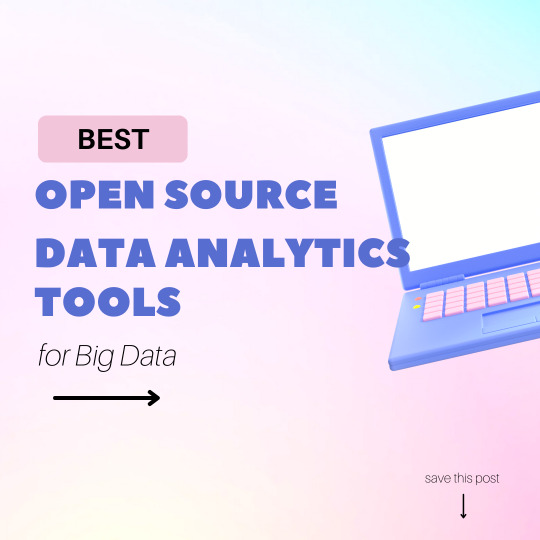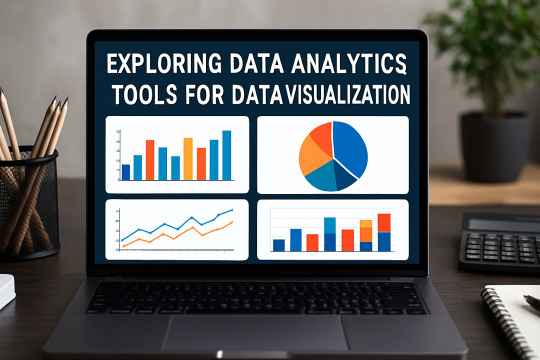#Data Analytics tools
Explore tagged Tumblr posts
Text
Exploring Data Analytics Tools for Data Visualization
Data analytics tools play a crucial role in transforming raw data into meaningful insights through visualization. Tools like Tableau, Power BI, and Google Data Studio help users create interactive dashboards and charts, making complex data easier to understand. These platforms support real-time data integration, customization, and advanced analytics features, enhancing decision-making across industries. Open-source options like Python (with libraries such as Matplotlib and Seaborn) and R also provide flexibility for in-depth analysis. Exploring these tools allows businesses and individuals to uncover patterns, track performance, and present data-driven stories effectively and efficiently.
Read more: https://pinpdf.com/exploring-data-analytics-tools-for-data-visualization-197d6a39aa884c8c8fa88e8afd741235.html
0 notes
Text
#Data analytics Trends#data analytics tools#Data Analytics Predictions#data analyst training#digital school of delhi
0 notes
Text

Retailers face inventory mismanagement, demand fluctuations, and poor customer insights, impacting sales and profitability. Infoveave Pvt. Ltd. delivers retail analytics solutions, utilizing AI to track consumer behavior, forecast demand, and optimize pricing. With real-time data, retailers enhance supply chain efficiency, boost customer engagement, and maximize revenue through data-driven strategies.
#tools for data visualization#data visualization tools#unified data analytics platform#data visualization softwares#unified data management platform#data analytics tools#robotic process automation software
0 notes
Text
Top 5 Data Analytics Tools of 2025 for Smarter Business Decisions

In today’s data-driven world, selecting the right data analytics tool is key to making informed decisions and unlocking business potential. Companies like Netflix save billions by utilizing advanced data analytics, underscoring its importance. With the right tools, businesses can boost productivity and turn complex data into actionable insights.
Data analytics tools help interpret large datasets, transforming raw data into visualizations, reports, and predictions. These tools are essential across industries, enabling businesses to uncover trends, correlations, and drive strategic decisions.
Here are the top 5 data analytics tools for 2025:
Domo: Known for seamless data integration, real-time updates, and powerful analytics, Domo allows users to create customizable dashboards and collaborate effortlessly across teams. It supports numerous data sources and is ideal for enterprises.
Power BI: A favorite for Microsoft users, Power BI offers advanced data modeling, AI insights, and interactive dashboards. It supports various third-party integrations and is great for organizations of all sizes, offering a free version and flexible pricing.
Zoho Analytics: A self-service platform designed for SMBs, Zoho Analytics stands out for its easy-to-use interface, AI-powered insights, and integration with the Zoho suite. It’s perfect for businesses looking for a cost-effective solution.
Tableau: Renowned for its powerful data visualization and AI-driven insights, Tableau is popular for its interactive dashboards and seamless integrations with various data sources, though it comes at a premium price.
Adobe Analytics: Ideal for large enterprises, Adobe Analytics offers deep customer journey insights, robust segmentation, and predictive analytics. It integrates well with other Adobe Experience Cloud tools, making it perfect for businesses focused on digital marketing.
Choosing the right tool will empower your business, enhance data-driven decision-making, and uncover valuable opportunities for success.
0 notes
Text
smarttechdata
I am alexpaul working for smarttechdata as PR consultant. With more than 6 year’s experience in PR and Digital Industry, helping teams to achieve goals by streamlining the process.
#Smart Tech News#Latest Gadgets 2025#Technology Trends#AI and Machine Learning#Data Analytics Tools#Smart Home Technology#Emerging Tech Trends#Tech Reviews and Comparisons#Comprehensive Gadget Reviews#Best Tech for 2025#AI-Powered Gadgets#Smart Home Automation#Future Technology Predictions#Innovative Devices#Tech Data Analytics#Gadget Buying Guide#Tech Industry Updates#Digital Transformation#IoT Devices#Cutting-Edge Technology.
1 note
·
View note
Text
Herovired's Data Analytics Tools empower businesses to harness the power of data for informed decision-making. These tools offer robust features, including data visualization, predictive analytics, and real-time reporting, enabling users to uncover actionable insights. With user-friendly interfaces and advanced analytics capabilities, they streamline data analysis processes for enhanced business performance.Click here to learn more.
0 notes
Text
Discover how AWS enables businesses to achieve greater flexibility, scalability, and cost efficiency through hybrid data management. Learn key strategies like dynamic resource allocation, robust security measures, and seamless integration with existing systems. Uncover best practices to optimize workloads, enhance data analytics, and maintain business continuity with AWS's comprehensive tools. This guide is essential for organizations looking to harness cloud and on-premises environments effectively.
#AWS hybrid data management#cloud scalability#hybrid cloud benefits#AWS best practices#hybrid IT solutions#data management strategies#AWS integration#cloud security benefits#AWS cost efficiency#data analytics tools
0 notes
Text
"The Role of Data Analytics in Optimizing Mobile App User Experience?"

"Discover common Google Ads mistakes, learn how to avoid them, and improve your campaign performance to maximize ROI with strategic optimization tips."
#data analysis data analytics difference#data analytics courses#data analytics tools#data analytics process#optimising app#optimizing mobile app#data science or data analytics which is better
0 notes
Text
How Businesses Can Leverage Advanced Analytics Tools to Derive Actionable Insights
Whether you use them to inspect brand-value associations among target audiences or monitor competitors’ business merger announcements, modern data mining and insight extraction techniques surpass all stakeholder expectations. It is indeed not a coincidence that corporate spending on tech upgrades has increased over the past decades. This post will explain how businesses can leverage advanced analytics tools to derive sought-after actionable insights.
Examples of Advanced Business Analytics Tools for Businesses to Leverage
Advanced business analytics tools empower an organization to use data to make better strategic decisions. Indeed, advanced business analytics programs are power tools that a reputed data insights company might use to analyze large quantities of data to draw deep insights and help identify trends to optimize the running of operations and growth of businesses. Here are some of the most popular advanced business analytics tools.
1. Tableau
Tableau is famous for its good data visualization capability, which allows users to create interactive, real-time dashboards. It helps companies present complex data in an easily understandable manner so that they can present better decision-making capability. The connection of multiple data sources and ease of usability make SAS a favorite among data analysts.
2. SAS
SAS is one of the high-end analytics platforms that boasts predictive analytics, statistical analysis, and machine learning in a higher dimension. SAS is highly applied in every business and economy to help business people forecast trends, manage risks, and optimize resources using comprehensive data analysis.
3. Power BI
Microsoft Power BI is a functionality-rich dynamic reporting and data visualization tool. It plays well with other Microsoft software packages without failing at data transfer or slowing down performance, making it relatively easy for businesses already using the various offerings in Microsoft’s ecosystem for enterprise clients. Several data engineering services also rely on Power BI as it is a fantastic way to produce data reports from massive, complex datasets, quickly enabling businesses to make informed decisions.
4. Google Analytics
The online platform is a critical success tool that a business needs in its toolkit if it desires to know the performance of a website and the behavior of customers on that site. Google Analytics also gives real-time information about user engagement, traffic sources, and the effectiveness of marketing.
How Businesses Leverage Advanced Analytics Tools
1. Determine Your Requirements for Data
You cannot select a tool without knowing what type of data you might want to analyze or what insight you are looking to derive. It could be the behavior of your customer, operational efficiency in a company, financial forecasting, or market trends. Upon identifying your purpose, the appropriate tools and metrics will also be identified.
2. Select Appropriate Analytics Tool
Once the needs of data are determined, analytics tools need to be selected that can cater to those needs. For instance, if complex data visualization is needed, then Tableau would be a good fit. Dynamic reporting would be best suited with Power BI, whereas predicting models are just great with SAS, and web analytics shines with Google Analytics. Each tool brings in something unique, so getting the right one to the problem in the business is important.
3. Integrate Data Sources
Sophisticated analytics tools work effectively only when more than one source of data is connected. Ensure your tool interacts with systems on CRM, databases, marketing platforms, and financial systems. Through integrating all these sources, a business can have a consolidated view of operations and performance.
4. Use Predictive Analytics
Advanced tools include SAS or Power BI, enabling predictive analytics. Their AI-assisted features aid companies in predicting whether a trend will continue or decline. Besides being useful in identifying possible threats, those future scenario analyses will demonstrate potential customer behavior changes. Predictive analytics will allow a company to position itself above the rest of the competition by observing market changes.
5. Visualization of Insights
Use the visualization power of tools such as Tableau or Power BI to develop interactive dashboards where you can clearly communicate the story of data insights. Good visualizations help you find a clear pattern, report your findings, and make decisions that are based on data.
6. Iterate and Improve
Analysis of data is not something you do one time. Continuous monitoring and revising the metrics are essential. Accordingly, brands must update the datasets to improve the model and ensure that insights stay relevant and actionable. These updates must correspond to how business conditions change.
Conclusion
Modern data mining and analytics tools allow businesses to surpass stakeholder expectations by deriving actionable insights from extensive data volumes. Tools like Tableau, SAS, Power BI, and Google Analytics help businesses make informed decisions through advanced data visualization, predictive insights, and real-time monitoring.
Businesses must define their data needs, select appropriate tools, and integrate data sources to maximize those tools’ effectiveness. When they leverage predictive analytics, visualize insights, and continuously iterate to ensure insights remain relevant, leadership decision-making and team coordination improve, ensuring business resilience and timely project delivery.
0 notes
Text
How Data Analytics Tools Can Help You Swap Screen Scrolling for Strategic Analysis

According to a major BI tool provider, even a 20% reduction in manual data entry and analysis could boost a company’s productivity by about 30%. This transformation begs the question: why is data analytics important for businesses today?
Data analytics tools are transforming the business landscape, turning raw data into strategic gold. Isn’t it time you shifted from manual data trawling to streamlined, insightful analysis?
Let’s explore how embracing data analytics tools can elevate your business from data-drowned to insight-driven.
Common Scenarios of Data Overload

The Toll on Productivity and Decision-Making
The impact of data overload extends beyond mere inefficiency. It directly influences the quality of decision-making within companies. When data analysts spend disproportionate amounts of time managing data, they have less time to interpret this data and make strategic decisions. According to studies, analysts can spend up to 80% of their time merely preparing data, which drastically reduces the time available for actual analysis. This imbalance highlights why data analytics is important for businesses today — it shifts the focus from data management to data utilization.

Key Features of Data Analytics Tools That Enhance Analysis
Data analytics tools are indispensable in today’s business environment, significantly enhancing the ability to handle vast amounts of data efficiently. Here’s an in-depth look at how these tools streamline processes and reduce reliance on manual data exploration, aligning perfectly with the importance of data analytics in business.
Automated Data Aggregation and Integration
Data analytics tools automate the collection and integration of data from various sources, consolidating disparate data sets into a single, coherent framework. This automation eliminates the time-consuming task of manually gathering and merging data, thereby enhancing data accuracy and availability. Automated integration supports real-time data analytics by ensuring data is consistently up-to-date and accessible, making it a cornerstone for businesses today.
Real-Time Data Processing
The capability to process data in real-time is a transformative feature for businesses that require immediate insights to make quick decisions. Real-time data analytics tools process information as it comes in, drastically cutting down the time lag between data collection and business insight generation. This immediacy helps businesses stay agile, respond to market changes swiftly, and maintain competitive advantage.
Interactive Dashboards and Visualizations
Interactive dashboards and visualizations turn complex data sets into understandable and actionable insights. These features allow users to manipulate and explore data in intuitive ways, significantly reducing the need for deep statistical knowledge or extensive data exploration. Dashboards provide a dynamic interface where users can drill down into metrics and trends important to their specific roles, enhancing decision-making across all levels of an organization.
Predictive Analytics and Trend Forecasting
Predictive analytics and trend forecasting utilize historical data to identify patterns and predict future outcomes. This aspect of data analytics tools is crucial for strategic planning, risk management, and discovering new opportunities. By forecasting trends, businesses can proactively adjust strategies and optimize operations, thereby underscoring why data analytics is essential for businesses today.
Reduction in Manual Data Exploration
Together, these features mitigate the need for manual data exploration by providing a suite of tools designed to automate, visualize, and predict data trends effectively. This shift not only saves time but also allows business users and data analysts to focus on higher-value activities, such as strategic analysis and decision-making, which are pivotal in today’s data-driven business landscape.
How BI Tools Foster a Strategic Mindset
Business Intelligence (BI) tools are pivotal in shaping a strategic mindset within organizations, enabling them to tackle business challenges proactively. Here’s an in-depth analysis of how BI tools contribute to fostering this essential business approach.
Fostering a Proactive, Strategic Approach
BI tools empower organizations to move from reactive problem-solving to proactive strategizing. By providing comprehensive data analysis capabilities, these tools help identify patterns, trends, and anomalies, allowing businesses to anticipate issues and opportunities. This proactive approach not only solves problems before they arise but also identifies strategic opportunities that might not be visible without deep data insights.
Cultivating a Data-Driven Culture
At the heart of a strategic mindset fostered by BI tools is the development of a data-driven culture. This culture prioritizes data in decision-making processes, ensuring decisions are based on evidence rather than intuition. BI tools catalyze this shift by making data accessible and interpretable to all levels of an organization, from executives to front-line employees. This widespread access to data fosters transparency and encourages all employees to base their decisions on data, enhancing the overall strategic alignment of the organization.
Enhancing Resource Allocation, Customer Understanding, and Market Responsiveness
Strategic analysis through data analytics tools is crucial for optimizing business operations, enriching customer interactions, and adapting swiftly to market changes. Here’s how these tools create significant impacts:
Better Resource Allocation
Strategic analysis facilitated by BI tools allows businesses to allocate resources more effectively. By analyzing data on operational efficiency, customer behavior, and financial performance, companies can identify areas where resources can be optimized to increase ROI. This kind of targeted allocation minimizes waste and maximizes output, highlighting the importance of data analytics in business for ensuring sustainable growth.
BI tools enhance resource allocation by integrating predictive analytics that forecast future trends based on historical data. This technical capability allows businesses to simulate various scenarios and their potential impacts on resources, enabling decision-makers to allocate budgets and manpower with greater precision. For instance, machine learning algorithms can predict seasonal demand fluctuations, helping businesses prepare inventory and staffing levels accordingly.
Improved Customer Understanding

Improving customer understanding goes beyond basic analytics; it involves sophisticated data segmentation and machine learning models that identify customer patterns and preferences. BI tools can dissect large datasets to create detailed customer profiles, which are crucial for personalized marketing and product development. Techniques such as clustering and classification provide a granular view of customer behaviors, enhancing targeted marketing efforts and boosting customer engagement rates.
Enhancing customer understanding directly supports why data analytics is important for businesses today, driving tailored strategies and improved customer engagement.
Enhanced Market Responsiveness

Enhanced market responsiveness is achieved through stream analytics, a feature of modern BI tools that processes data in real time as it flows into the system. This capability allows businesses to react instantaneously to market changes — from stock price fluctuations to social media trends — ensuring that the business remains proactive rather than reactive. The technical underpinning of stream analytics involves complex event processing engines and real-time data dashboards that provide ongoing insights into market conditions.
Conclusion
In a world inundated with data, shifting from tedious screen scrolling to strategic analysis is not just an upgrade — it’s a transformation. Data analytics tools are everything when making this shift, empowering businesses to harness the true potential of their data swiftly and smartly. With tools like Grow, businesses can leverage advanced analytics capabilities to streamline processes, enhance decision-making, and ultimately drive success.
Ready to experience the power of data without the clutter? Start with Grow’s 14-day free trial and explore how intuitive and impactful analytics can be. Don’t just take our word for it — check out the numerous Grow reviews from verified users on Capterra. Dive into the world of Grow and turn your data into decisions today!
Original Source: https://bit.ly/3XAcLoT
#Data Analytics tools#the importance of data analytics in business#why is data analytics important for businesses today#real-time data analytics
0 notes
Text

With the field of data analytics constantly evolving, organizations are embracing open-source tools due to their flexibility, lower pricing, and solid features. Open-source applications, including data analysis and data visualization tools, are useful for organizations that want to use their data efficiently. This article focuses on the best open-source data analytics tools, their comparison, and tools that will suit organizational requirements best.
https://www.sganalytics.com/blog/open-source-data-analytics-tools/
#data analytics tools#open source data analytics#open source tools#open source#big data#data analytics
0 notes
Text
Exploring Data Analytics Tools for Data Visualization

Data analytics tools for data visualization help transform complex data into intuitive visuals, enabling better insights and decision-making. Popular tools include Tableau, known for interactive dashboards; Power BI, which integrates seamlessly with Microsoft products; Google Data Studio for easy sharing and collaboration; and Looker, offering data modeling capabilities. Qlik Sense provides strong associative data indexing, while D3.js allows highly customized visuals for developers. These tools support various chart types, real-time updates, and data connectivity. Choosing the right tool depends on your technical expertise, data needs, and collaboration requirements, making data visualization a key element in effective analytics strategies.
Read more: https://cirandas.net/khushnuma123/blog/exploring-data-analytics-tools-for-data-visualization
0 notes
Text
youtube
Looking to harness the power of data to drive your business forward? In this video, we’ll show you how to get data insights that matter—quickly and efficiently. Whether you’re new to data analytics or just want to refine your approach, this step-by-step guide will help you unlock the full potential of your business data. What You’ll Learn: How to identify and prioritize your data sources The best data analytics tools for your business How to ask the right questions to extract meaningful data insights Turning insights into action for data-driven decision making Data is the new currency, and understanding it is key to gaining a competitive edge. Whether you’re in business intelligence, data analytics, or simply want to make smarter decisions, this video is packed with practical tips you can start using today. Want to take your data strategy to the next level?
Visit Vuelitics to explore advanced business intelligence and data analytics solutions that can transform the way you operate. We provide tools and expertise to help you uncover patterns, predict future trends, and make informed decisions.
Connect With Us: Facebook: https://www.facebook.com/profile.php?id=61560856345182&sk=about_details Instagram:https://www.instagram.com/vuelitics_velan/ Twitter:https://x.com/vuelitics Linkedin: https://www.linkedin.com/company/vuelitics/ Youtube: https://www.youtube.com/@Vuelitics Website: https://vuelitics.com/
#business analytics#artificial intelligence#data#ai#ai in business#machine learning#insights#analytics#data insights#business intelligence#data analytics#data-driven decision making#business data#data analytics tools#actionable insights#data strategy#business growth#BI tools#data management#Vuelitics#data solutions#predictive analytics#business intelligence solutions#Youtube
0 notes
Text
The Future of Data Visualization: Trends and Emerging Tools to Watch
In today's digital world, data is everywhere. Businesses, researchers, and individuals rely on data to make decisions, track progress, and discover insights. However, raw data is often complex and difficult to understand. This is where data visualization comes in. By transforming numbers into charts, graphs, and interactive visuals, data visualization makes information easier to interpret and use. As technology continues to evolve, so do the tools and trends shaping the future of this field. In this article, we will explore the latest developments in data visualization and the emerging tools to watch.
The Rise of AI and Automation
Artificial Intelligence (AI) is changing the way we visualize data. AI-powered tools can automatically analyze data, detect patterns, and generate visualizations without requiring manual input. This reduces the time and effort needed to create meaningful insights. AI can also personalize visualizations, ensuring they highlight the most relevant information for different users.
One key trend is automated data storytelling. Instead of simply displaying charts, AI-driven platforms now generate narratives explaining key trends and insights. This makes it easier for users, even those without technical expertise, to understand the story behind the data.
Interactive and Real-Time Dashboards
Static charts are becoming a thing of the past. Modern businesses demand interactive dashboards that allow users to explore data dynamically. Interactive dashboards let users filter, zoom, and drill down into specific details, offering a deeper understanding of the data.
Real-time data visualization is also gaining importance. Many industries, such as finance and healthcare, rely on live data feeds to make immediate decisions. Tools that support real-time updates ensure that users always have access to the most current information, helping them react quickly to changes.
Augmented and Virtual Reality (AR/VR) in Data Visualization
One of the most exciting developments in data visualization is the integration of augmented reality (AR) and virtual reality (VR). These technologies allow users to interact with data in a 3D space, making it easier to spot patterns and relationships that may be hidden in traditional 2D charts.
For example, companies can use VR to create immersive environments where analysts can explore complex datasets in a more intuitive way. Similarly, AR can overlay real-time data onto the physical world, helping industries like manufacturing and logistics improve efficiency.
The Power of No-Code and Low-Code Platforms
Not everyone is a data scientist or a programmer, and that’s where no-code and low-code tools come in. These platforms allow users to create stunning visualizations without writing a single line of code. With drag-and-drop interfaces and pre-built templates, anyone can transform raw data into meaningful insights.
Popular tools in this category include Tableau, Power BI, and Google Data Studio. As these platforms continue to improve, we can expect even more accessibility for businesses and individuals looking to harness the power of data visualization tools.
Data Democratization and Collaboration
Data is no longer confined to IT departments. More organizations are adopting a data-driven culture, where employees at all levels have access to insights. This shift is known as data democratization.
Collaborative tools are making it easier for teams to share and analyze data together. Cloud-based platforms allow users to work on the same dashboard from different locations, ensuring that insights are easily accessible to everyone in an organization. This trend is making data more inclusive and empowering non-technical users to make data-driven decisions.
Ethical and Responsible Data Visualization
As data visualization becomes more powerful, it also carries ethical responsibilities. Misleading charts, incorrect scaling, or selective data representation can create false narratives. Businesses and organizations must focus on ethical data visualization by ensuring accuracy, transparency, and fairness.
Additionally, accessibility is an important factor. Visualizations should be designed to accommodate individuals with disabilities, including those with color blindness or visual impairments. Tools that offer adaptive color schemes and alternative text descriptions will play a crucial role in making data accessible to all.
Tools for data visualization are constantly evolving, making it easier than ever to turn raw data into compelling visuals.
Final Thoughts
The future of data visualization is bright and full of possibilities. AI-driven automation, real-time interactivity, AR/VR advancements, and no-code solutions are all transforming the way we interact with data. Ethical considerations and accessibility will also play a key role in shaping the industry. As new tools and technologies continue to emerge, businesses and individuals must stay updated to make the most of their data visualization strategies. By embracing these trends, we can unlock deeper insights, improve decision-making, and create a more data-driven world.
#robotic process automation software#rpa software#data visualization softwares#tools for data visualization#unified data management platform#data visualization tools#data analytics tools#unified data analytics platform
0 notes
Text
Discover the challenges of implementing data analytics in Abu Dhabi and learn strategies to overcome them. Explore issues related to skills, data privacy, system integration, data quality, and costs.
#Data analytics in Abu Dhabi#Data Analytics Company#data analytics projects#Data Analytics#Data Analytics Tools#Data Analytics Techniques#Data Analytics Courses
0 notes
Text
Enhancing Mindfulness with Technology and Natural Abilities
Discover powerful strategies to enhance patternicity and synchronicity for mindful living! Learn how to leverage technology for deeper self-awareness. Read our latest article and subscribe now for more insights on transforming your life!
#dataanalyticstools#digitaljournaling#gratitudepractice#HafsaReasoner#intuitiondevelopment#journaling#meditation#meditationapps#MindfulLiving#mindfulnessmeditation#mindmappingsoftware#OvercomingChallenges#patternicity#SelfAwareness#socialmediaalgorithms#synchronicity#technologyandmindfulness#data analytics tools#digital journaling#Empowered Journey#gratitude practice#Hafsa Reasoner#intuition development#Meditation#meditation apps#mind mapping software#Mindful Living#Mindfulness#mindfulness meditation
0 notes